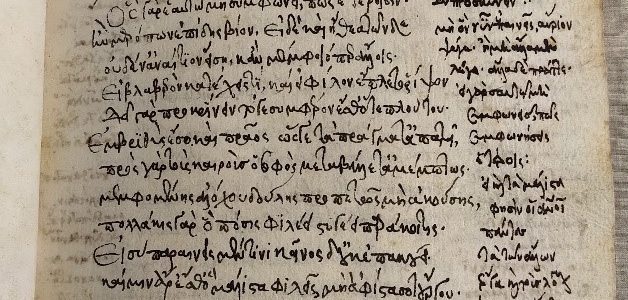
The Polonsky Foundation Greek Manuscripts Project: quires reunited
Cataloguing the Greek manuscripts of Cambridge in the context of the Polonsky Foundation project allows new insight in the collections. By examining the manuscripts one by one, both from the textual and physical point of view, the team of cataloguers is able to observe details which lead to a better understanding of the books and their history . It is also possible to recognise links between different manuscripts. For example, within the University Library collection, it was possible to identify that a fragment was originally part of another manuscript. Another case in the same collection shows how manuscripts which have had an independent existence for several centuries once belonged together.
MS CUL Ff.4.47, datable to the first half of the sixteenth century, is a miscellany comprising texts of various genres and ages, which have in common their use for educational purposes in Byzantium: two collections of gnomic sententiae, poems by the Cappadocian Father Gregory of Nazianzos, books 20 and 22 of Homer’s Iliad, the tragedy Alexandra by Lycophron, and two short grammatical texts on declensions. Particularly significant is the presence of Alexandra, with scholia, a quite obscure, mysterious and difficult text, which, due to its linguistic characteristics, was very popular as a teaching text in Byzantium. The texts were copied by two contemporary hands, the hieromonk Sabbas of the Dionysiou monastery on Mount Athos (RGK I, 359), who signed and copied almost the whole manuscript, and an anonymous scribe (hand B), who copied just the text of Lycophron’s Alexandra.
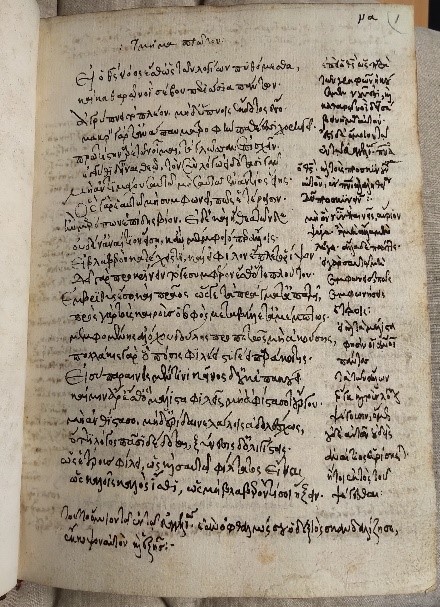
Ff.4.47, f. 1r (hand of hieromonk Sabbas) 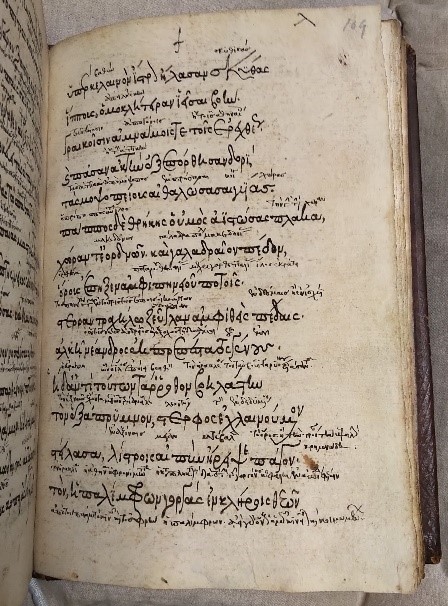
Ff.4.47, f. 109r (text by hand B, interlinear glosses by hieromonk Sabbas)
However, a closer look at the material characteristics of the manuscript reveals a more complex history behind this book. The codex is in fact a composite formed by two contemporary parts, folios 1-24 and 25-118. Although Sabbas’s hand appears in both parts and the texts are written on the same kind of paper (the same watermark representing a bull’s head is found in both parts of the codex), the two parts are immediately distinguishable due to the presence of two non-consecutive sequences of quire signatures, written by Sabbas. The three quires which form the first part are numbered να΄-νγ΄ (51-53) while the quires of the second part are numbered κα΄-λ΄ (21-30). (Greek scribes use alphabetical sequences to represent numbers.)
Therefore, it is clear that the second part originally preceded the first. Moreover, it can be concluded that quite a lot of the manuscript is missing: where are the quires with signatures α΄-κ΄ (1-20) and λα΄-ν΄ (31-50)?
MS Ff.4.47, as stated by the monk Sabbas himself, was written in the Dionysiou monastery on Mount Athos. In fact it belongs to a group of Greek manuscripts now in the CUL (including Nn.3.3, Νn.3.14, Nn.3.15, Nn.3.16, Nn.3.17), which share this common origin, and which previously belonged to the physician Richard Mead (1673-1754) and, after him, to the physician and bibliophile Anthony Askew (1722-1774). One of the missing parts of MS Ff.4.47, as originally suggested by Professor Patricia Easterling, is to be found precisely in one of these other Dionysiou codices, MS Nn.3.14, containing tragedies by Euripides.
MS Nn.3.14 is a composite manuscript, made up of two non-contemporary parts. The first part (ff. 1r-121v) is datable to the early fourteenth century and contains three plays by Euripides (Hecuba, Orestes, Phoenician Women). The second part (ff. 122r-209v) was written later, in the sixteenth century, and contains Hecuba and Orestes by Euripides followed by a grammatical text. It is this second part that was probably originally bound together with MS Ff.4.47. The same two hands, Sabbas and hand B copied the texts; the quires are numbered [μ΄]-ν΄ (40-50) in Sabbas’s hand, partly filling the incomplete series found in Ff.4.47; the same paper is used as in Ff.4.47, with the bull’s head watermark.

Nn.3.14, f. 202r (text by hand B); in the upper edge signature of the last quire ν΄ (50) 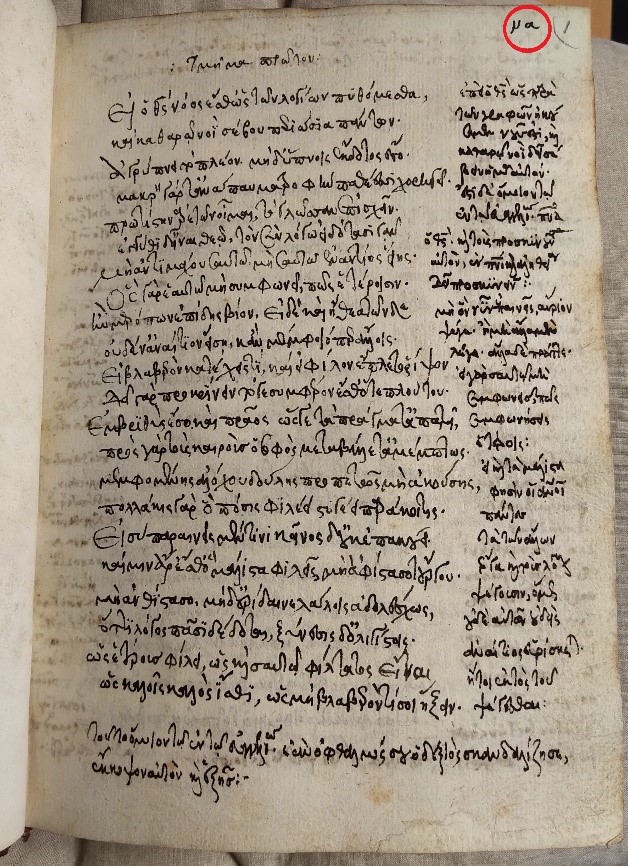
Ff.4.47, f. 1r (text by Sabbas); in the upper edge signature να΄ (51)
We are therefore able to reconstruct at least a part of the original manuscript:
| Ff.4.47(2) | Nn.3.14(2) | Ff.4.47(1) | ||
| [missing quires] | quires 21-30 | [missing quires] | quires 40-50 | quires 51-53 |
The re-introduction of the texts contained in Nn.3.14 part 2 into Ff.4.47 confirms its character as a didactic miscellany: in Byzantium the tragedies of Euripides, Hecuba and Orestes in particular, were very popular texts in a scholastic context.
At present the remaining missing parts of the original manuscript have not been identified. Moreover, the exact moment when the original manuscript was dismembered remains to be precisely clarified. Surely the division and re-assembly of the manuscript’s parts had already taken place when the manuscripts entered CUL in 1785 as an acquisition from the collection of Anthony Askew: the descriptions of MSS Ff.4.47 and Nn.3.14 in the catalogue of Askew’s sale correspond to the present state of the manuscripts. Therefore the rearrangement probably occurred while the manuscripts were in possession of Askew himself, or previously, when they were owned by Mead. While further research needs to be done on this point (the issue is complex and involves also the other manuscripts deriving from Dionysiou Monastery, on the subject of which Smith 1970, Stubbings 1976, Easterling 2000 are useful), only suggestions can be made for the moment.
Such reconstructions are of course important from a philological point of view, in understanding the tradition of the texts conveyed by the manuscripts. But, as this case shows very well, they bear added significance from a historical and cultural perspective, showing how books can be used and reused in a variety of contexts. When this miscellany, a quite traditional collection of texts in a Byzantine milieu, was placed in a new context, that of English antiquarian scholar-collectors of the 17th-18th centuries, it was divided and the texts recombined in order to form new books. In MS Ff.4.47 the reorganisation of the material was limited to removal and reordering but the part of the original manuscript now in MS Nn.3.14 was bound together with a portion of an older manuscript containing the same tragedies by Euripides, evidently in order to form a homogeneous collection of texts by the same author. This raises the question, whether this was done in response to a “philological need”, for example in order to compare different text’s traditions.
As the example of MS Ff.4.47 shows, examining and describing the manuscripts for the catalogue allows us to gather new information but can generate more questions which entail further study. The project’s aim, by providing full digitisation of the manuscripts within an interpretative framework, is precisely to encourage and facilitate further research on the collections.
Erika Elia
Bibliography
P. Easterling, From Britain to Byzantium: the study of Greek manuscripts, in: R. Cormack, E. Jeffreys (eds.), Through the looking glass. Byzantium through British eyes (Papers from the Twenty-ninth Spring Symposium of Byzantine Studies, London, March 1995), Adershot-Burlington USA-Singapore-Sidney 2000, pp. 107-120
O.L. Smith, “Notes and Observations on some Manuscripts of the Scholia on Aeschylus”, Classica et Mediaevalia 31 (1970), pp. 14-48
F. Stubbings, “Anthony Askew’s ‘Liber amicorum'”, Transactions of the Cambridge Bibliographical Society 6 (1976), pp. 306-321
A. Turyn, The Byzantine Manuscript Tradition of the Tragedies of Euripides Urbana 1957


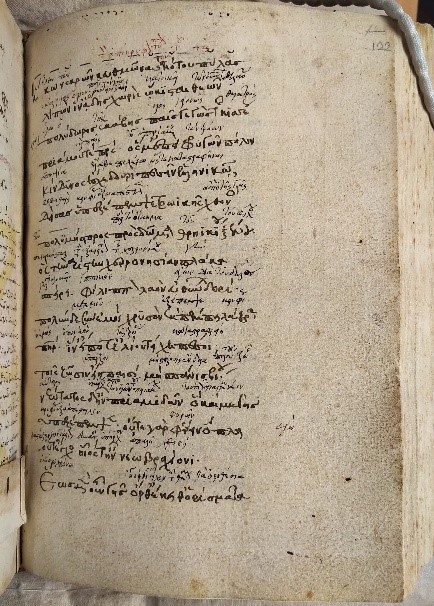
Thank you for sharing this detailed information. You mentioned the date of 1785 as the date that MS Nn.3.14 (the 16th-century composite manuscript) came into the universities’ possession. Were there any early Greek plays that were in the universities’ possession prior to the 18th century, that Elizabethian students may have had access to?